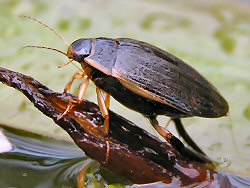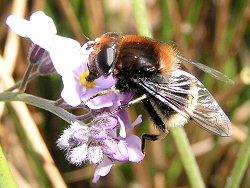That one phrase probably sums up what I love most about gardening for wildlife. Whenever you get the chance to spend a few hours in the garden tuning into the wildlife there, the chances are that you will see something different to that which you have seen before.
 Water beetle basking in sunshine.
Water beetle basking in sunshine.
Yesterday I was sitting by my garden pond when I saw a large diving beetle (species unknown) swimming just below the surface. I'd already seen them a couple of times this year, so this was not a surprise. However, as I watched, the beetle hauled itself out of the water on the stem of some cape pondweed (
Aponogeton distachyos), where it proceeded to preen itself - rubbing is hind legs together. It remained in this position in full sunshine for some time - long enough for me to fetch my camera and take this photograph. This is the best, and most unexpected, view of this animal I've ever had.
There are something like 250 species of hoverfly in Britain with about 40 of them being common enough to be seen in many gardens. Because they are so well marked, they are relatively easy (with the aid of a good field guide) to get to know. I've probably recognised about 20 of them in my garden - so there is always a chance of seeing a new one.
 The hoverfly Eristalis intricarius (female) on forget-me-not (Myosotis sp.).
The hoverfly Eristalis intricarius (female) on forget-me-not (Myosotis sp.).
That happened today when I noticed a hoverfly which was obviously a very good bumblebee mimic (in shape and colouration) feeding on the kingcups (
Calthus palustris) and forget-me-nots (
Myosotis sp.) around the pond. From the pictures I took (this was one of the most approachable and easily photographed species I've encountered) and my field guide (
Naturalist's Handbook 5: Hoverflies) I was able to identify it as a female
Eristalis intricarius. This was a beautiful animal - the brandy-coloured hairs of the thorax being particularly bright when the light shone through them.
These two encounters remind me why I love gardening for wildlife - you just never know what you are going to see. With plants there are the odd happy accidents and surprises, but, by and large, we know what will appear and when. But animals will not be told where to go and when to appear. Of course some have predictable habits, but their diversity is such that they always have the capacity to surprise. It's the excitement and drama of these encounters that draws me, time and time again, into the garden. I can no more imagine my garden without them than I can my house without windows.